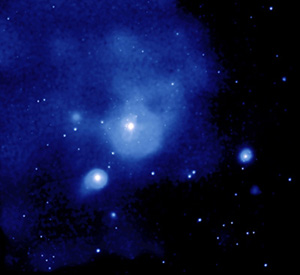September 8, 2004
CXC RELEASE: 04-10
A nearby galaxy cluster is facing an intergalactic headwind as it is pulled by an underlying superstructure of dark matter, according to new evidence from NASA's Chandra X-ray Observatory. Astronomers think that most of the matter in the universe is concentrated in long large filaments of dark matter and that galaxy clusters are formed where these filaments intersect.
A Chandra survey of the Fornax galaxy cluster revealed a vast, swept-back cloud of hot gas near the center of the cluster. This geometry indicates that the hot gas cloud, which is several hundred thousand light years in length, is moving rapidly through a larger, less dense cloud of gas. The motion of the core gas cloud, together with optical observations of a group of galaxies racing inward on a collision course with it, suggests that an unseen, large structure is collapsing and drawing everything toward a common center of gravity.
"At a relatively nearby distance of about 60 million light years, the Fornax cluster represents a crucial laboratory for studying the interplay of galaxies, hot gas and dark matter as the cluster evolves." said Caleb Scharf of Columbia University in New York, NY, lead author of a paper describing the Chandra survey that was presented at an American Astronomical Society meeting in New Orleans, LA. "What we are seeing could be associated directly with the intergalactic gas surrounding a very large scale structure that stretches over millions of light years."
The infalling galaxy group, whose motion was detected by Michael Drinkwater of the University of Melbourne in Australia, and colleagues, is about 3 million light years from the cluster core, so a collision with the core will not occur for a few billion years. Insight as to how this collision will look is provided by the elliptical galaxy NGC 1404 that is plunging into the core of the cluster for the first time. As discussed by Scharf and another group led by Marie Machacek of the Harvard-Smithsonian Center for Astrophysics in Cambridge, Mass., the hot gas cloud surrounding this galaxy has a sharp leading edge and a trailing tail of gas being stripped from the galaxy.
"One thing that makes what we see in Fornax rather compelling is that it looks a lot like some of the latest computer simulations," added Scharf. "The Fornax picture, with infalling galaxies, and the swept back geometry of the cluster gas - seen only with the Chandra resolution and the proximity of Fornax - is one of the best matches to date with these high-resolution simulations."
Over the course of hundreds of millions of years, NGC 1404's orbit will take it through the cluster core several times, most of the gas it contains will be stripped away, and the formation of new stars will cease. In contrast, galaxies that remain outside the core will retain their gas, and new stars can continue to form. Indeed, Scharf and colleagues found that galaxies located in regions outside the core were more likely to show X-ray activity which could be associated with active star formation.
The wide-field and deep X-ray view around Fornax was obtained through ten Chandra pointings, each lasting about 14 hours. Other members of the research team were David Zurek of the American Museum of Natural History, New York, NY, and Martin Bureau, a Hubble Fellow currently at Columbia.
NASA's Marshall Space Flight Center, Huntsville, Ala., manages the Chandra program for NASA's Office of Space Science, Washington. Northrop Grumman of Redondo Beach, Calif., formerly TRW, Inc., was the prime development contractor for the observatory. The Smithsonian Astrophysical Observatory controls science and flight operations from the Chandra X-ray Center in Cambridge, Mass.
Additional information and images are available at:
MEDIA CONTACTS
Steve Roy
Marshall Space Flight Center, Huntsville, AL
Phone: 256-544-6535
Megan Watzke
Chandra X-ray Observatory Center, CFA, Cambridge, MA
Phone: 617-496-7998
cxcpress@cfa.harvard.edu






